
Recently I have read a few articles about instances where Sikh leaders have partaken in activities with various anti-Sikh groups, such as the RSS and Dera Sacha Sauda.
In part, the controversies that have arisen are rooted in the questions of what role Sikh leader ought to play in the context of anti-Sikh propaganda. Should our leaders be attending functions organized by anti-Sikh groups? Should they boycott them? Many leaders have been seen “supporting” such organizations by hobnobbing with, accepting gifts from, and turning a blind eye to their activities.
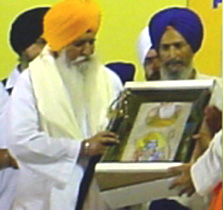
One recent instance of this is the Jathedar of the Akal Takht and others accepting pictures which expressly co-mingle Sikhi with Hinduism (with Guru Nanak Dev Ji and Sri Ram) at an RSS function. It may not seem like a big deal, but one of the RSS’s assertions is that Sikhs are derivatives of Hinduism and that the Guru’s are the descendants of the Hindu God Ram. I wonder if anyone else feels that our Jathedar’s acceptance of such a picture is a bit shady? As a Sikh I expect my leaders to stand up for Sikh beliefs and the Sikh identity – not accept memorabilia which dilutes my identity and depicts something that they sit on stages across the globe and negate.
As I write this post, I realize that some of you may be thinking that of the instance above does not amount to much, but I think it is illustrative of a much larger issue …if our leaders do not take a stand on something as simple as “Sikhi and Hinduism are not the same,” then where does that leave us as a Sikh nation? How are we to face other challenges to our identity in the West? What are our expectations of our leaders? And are there any avenues we can take to enact change?
Although this blog is new, I couldn’t resist getting the in the ‘countdown’ spirit with another useless list. Oh well, the end of the calendar year (although not the Nanakshahi Sikh calendar) gives us some time for thoughts and reflections. Here is my list of this year’s top 5 events that will influence 2008 and beyond.
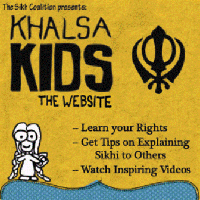 5. Khalsa Kids – The Sikh diaspora is coming of age and creating new tools for the community. It has been over ten years since the suicide of 13 year old Vijay Singh in the UK after being repeatedly bullied in school. Unfortunately the bullying of young Sikh boys tends to be the rule and not the exception. The Sikh Coalition released a harrowing report that showed 77.5% of Sikh boys surveyed in Queens reported being teased or harassed on account of their Sikh identity. However, the community is beginning to respond and it reveals a coming of age here in the US Sikh population.
5. Khalsa Kids – The Sikh diaspora is coming of age and creating new tools for the community. It has been over ten years since the suicide of 13 year old Vijay Singh in the UK after being repeatedly bullied in school. Unfortunately the bullying of young Sikh boys tends to be the rule and not the exception. The Sikh Coalition released a harrowing report that showed 77.5% of Sikh boys surveyed in Queens reported being teased or harassed on account of their Sikh identity. However, the community is beginning to respond and it reveals a coming of age here in the US Sikh population.
A Sikh teacher, SriNam Singh Khalsa, recently published Break the Bully Cycle: Intervention Techniques and Activities to Create a Respectful School Community. This book provides strategies to enable school teachers and administrators in helping not only the victims of bullies, but also the bullies themselves. Another book, written by a Sikh high school student, Harkirat Singh Hansra, helps to give non-Sikhs, especially students, a basic understanding on Sikhi. Titled Liberty at Stake – Sikhs: The Most Visible Yet Understood Minority in America provides a Sikh teenager’s perspective of the world around him. Finally, perhaps the most innovative project was the Sikh Coalition’s launch of its Khalsa Kids website. Fun, interactive, and professional the Sikh Coalition must be commended for creating a real tool that will serve Sikh communities throughout the world. That the Sikh community has a multi-faceted approach and is using its resources is a great success of 2007 that will set the bar for 2008 and beyond.
 As we celebrate the New Year and look forward to what it holds in store for us (at the very least an election!), it is important to look back and remember what we have experienced as a community this past year. In celebration of the Sikh Diaspora and what it represents to us today, here is a look back at some of the global stories, books, films and websites that impacted our community in 2007.
As we celebrate the New Year and look forward to what it holds in store for us (at the very least an election!), it is important to look back and remember what we have experienced as a community this past year. In celebration of the Sikh Diaspora and what it represents to us today, here is a look back at some of the global stories, books, films and websites that impacted our community in 2007.
- Young Sikh Men Get Haircuts, Annoying Their Elders. “It’s usually college-going students who are more worried about looking good than about their spiritual identity…[It] releases a certain amount of pressure.”
- A new website, Sikh Chic, discussing articles related to the art and culture of the Sikh Diaspora was launched. “We need to re-think the Sikh idea in the North American idiom, in our language, in our way of articulating our thoughts.”
- The Sikh clergy issues an edict directing the Sikh Sangat to snap all ties, including social, religious and political, with Baba Ram Rahim Gurmit, head, Dera Sacha Sauda, and its followers.
- Several books for and about Sikhs are published and discussed including Shame, Sacred Games, Sikhs in Britain, Londonstani, Sikhs Unlimited, I See No Stranger: Early Sikh Art and Devotion.
- A Sikh-Canadian group slams the long-standing immigration policy that forces people with the surname Singh or Kaur to change their last names. It was later noted that the immigration letter sent out was poorly worded.
As I have been thinking about the Sikh community’s mobilization against post-9/11
I feel as though the discourse on Sikhs being the targets of racial profiling has really been about keshdari Sikhs. I must preface this argument with the statement that I understand the issues that khesdari Sikh men face every day are quite different than those of clean-shaven Sikhs. The experience of physically looking quite different than the majority of the clean-shaven population, regardless if it’s brown, white, yellow, or pink, that surrounds you does not make it “easy” to blend in. I sympathize and, more importantly, respect and admire your actions to keep your khes (i.e. hair) as a symbol of your Sikh identity. Furthermore, I undoubtedly agree that keshdari Sikhs have been the targets of racial profiling and victims of hate crimes following the events of 9/11 because “they look like Osama Bin Landen” and “all the other bad guys in
I have heard of a few cases of clean-shaven Punjabi Sikh men being racially profiled and harassed as our Arab and Muslim brothers … I would not doubt it happening to Latino men too. I remember one clean-shaven Punjabi Sikh gentlemen sharing his experience with racial profiling immediately following the 9/11 attacks in the film, “Divided We Fall: Americans In The Aftermath”. These stories made me wonder if Sikh organizations, such as the Sikh Coalition and SALDEF, have made a concerted effort to reach out to clean-shaven Punjabi Sikh men to document and represent their experiences in petitions and memos sent to policy makers and politicians about Sikh racial profiling. Or are these men not Sikh “enough” to be part of the discussion? Some could argue that it is the external representation of Sikh identity that is being targeted for racial profiling, such as the turban and beard; clean-shaven Sikh men don’t display either of those markers. However, I would argue, aren’t the majority of khesdari Sikh men being targeted because they are also “brown”? They are the ones I have commonly seen being represented in films, commercials, and literature on the fight against Sikh racial profiling. Hence, isn’t there a shared history of discrimination and profiling based on “dark” features” along with a common religious belief system, regardless of the varied decisions made by Punjabi Sikh men on keeping their hair?
Earlier this week the Haryana and Punjab high courts struck down a provision in SGPC-run schools that reserves 50% of its seats for Sikhs under the same concept as the federal provision for reserved seats for historic minorities. The SGPC is contesting the ruling, arguing that while Sikhs may constitute a majority of the Punjabi population, Amritdhari Sikhs, for whom seats are reserved, are a very small comparative minority.
This issue made me think of previous conversations I’ve had with friends over whether or not Amritdhari Sikhs, or even just Keshdari Sikhs, are a shrinking minority. Within the diaspora this is certainly the case — the number of Sikhs, particularly second- and third-genners, who choose to take amrit seems to decrease every year. I’ve met many folks who discuss their hesitancy; perhaps we don’t know Punjabi as well in the diaspora, or the lack of training within sangats makes it hard to pass on knowledge. But for many, being an Amritdhari Sikh also vastly limits their relationship choices and options.
As a community, do we see this as a problem? I always find this news disheartening, but I would be lying if I said I would line up to take amrit anytime soon. How does the growing expansion and changes of the demographics of the Sikh community make things easier, or more challenging, when it comes to advocating for issues together? Do different subsections of the population feel more or less lonely/alone in their experiences?
Shonali Bose, writer and director of the acclaimed 2005 film Amu (which powerfully uncovered the brutal realities of 1984) has just 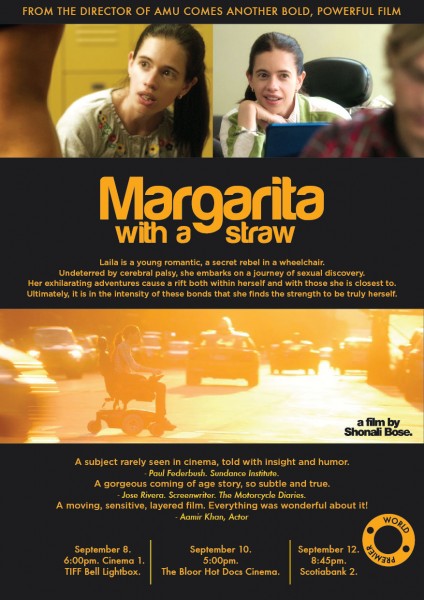 completed a new feature film called Margarita, with a Straw. Premiering next week at the Toronto International Film Festival, the film is a coming of age love story about a part-Sikh college student from Delhi named Laila who has cerebral palsy.
completed a new feature film called Margarita, with a Straw. Premiering next week at the Toronto International Film Festival, the film is a coming of age love story about a part-Sikh college student from Delhi named Laila who has cerebral palsy.
Given the popularity of Amu in the Sikh community, I wanted to interview Shonali about her new film, which explores equally important issues to those brought up in Amu—disability and sexuality among them. Read on for the full interview, and check out the trailer here.
What inspired you to make Margarita, with a Straw?
This my second film, which is inspired by my cousin sister Malini who has acute cerebral palsy. That’s a condition where the part of your brain that controls your motor skills is damaged at birth. But your emotional and intellectual abilities are intact. When I was 40 and Malini was 39, I asked her, what are we going to do for your 40th? It’s absolutely the best birthday. Her speech is usually garbled and difficult to understand. But sometimes when she is angry or excited – it comes out crystal clear. This was one of those times. She banged her fist on the table and spoke loud and clear: I just want to have sex by the time I’m 40! I grinned sheepishly and assured her it was not what it was made out to be, etc. But later when I was thinking about what she said, what she so passionately wanted – I realized that I had never thought about her sexuality much. Or maybe I just avoided it as I didn’t know what to do about it. This started me on my journey of Margarita.
As I started exploring my fictional character and her issues, the big question that came up was one of self worth. This is a core issue that everyone faces, whether one is disabled or not. From there it went to a place of finding deep self acceptance and self love.
I loved your first film, Amu, which powerfully highlighted the anti-Sikh pograms of 1984 through the eyes of a young Sikh woman. The main character in your new film is also a Sikh woman. Where does your interest in telling “Sikh stories” come from?
I don’t see them as Sikh stories at all. The 1984 genocide is a watershed in the entire subcontinent. Like Partition. I made a film about it because no one had and it was covered up. And this history had to get out. To me, this is not a Sikh issue. It’s an Indian issue. Thousands of innocent people being killed in the capital city in broad daylight, organized by those in power—30 years later justice still not delivered. Every justice loving Indian—every Indian who cares about right and wrong and about their country—should be as bothered by this issue as those who were made victims. That was the aim of Amu. In fact, the leads are all Bengalis. It’s only in the end that the lead protagonist, raised as a Hindu Bengali, finds out that she is Sikh and wears a kara.
When I was making Amu, the son of one of my investors—Bhajneet Singh Malik—told me that he was bothered by the fact that Sikhs are only shown as victims, terrorists, or buffoons in films. That remark stayed with me. It’s a fact. When I started creating characters for Margarita and was thinking of the father’s role, I thought it would be nice if I made him Sikh. As a tribute to Amu. To the community that has given me so much love and support on my first film. Balraj Kapoor is an ordinary middle class father. He also happens to be Sikh. He had a love marriage and married his college mate who is Maharashtrian. The actor playing this role was actually little Amu’s father who got killed in Amu.
Bhajneet also said that he hated when Sikhs were played by non-Sikhs who put a turban on. So it was very important to me once I made this decision to cast a real Sikh. My lead protagonist in Margarita is the daughter of this man, Laila Kapoor. She is half Punjabi, half Maharashtrian. Half Hindu. Half Sikh.
Guest blogged by Harleen Kaur

 Sangat: a concept that has been emphasized to me, and thus I have reiterated to others, for as long as I can remember. My mom telling me to be aware of the friends I was keeping at school, my camp counselors telling me that I should strive for sadh sangat, or people who will push me to be better in every moment.
Sangat: a concept that has been emphasized to me, and thus I have reiterated to others, for as long as I can remember. My mom telling me to be aware of the friends I was keeping at school, my camp counselors telling me that I should strive for sadh sangat, or people who will push me to be better in every moment.
As a young Sikh girl growing up in Wisconsin, sangat was something that was redefined for me every day. Although I found it in my peers on my softball team to my friends in the school musical, the sangat I truly desired was the one I found at gurdwara and at the local Sikh youth camp. With such a small Sikh community in Wisconsin, however, it was not something that was easily found. Sangat came in moments few and far between, and it was often something that I desired more than what I received.
Guest blogged by Shahe Kaur
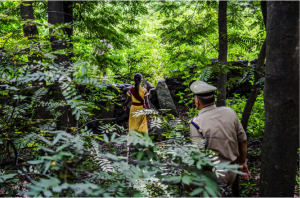
(Photo courtesy of Daniel Berehulak for The New York Times)
The story is not a scene from a movie or excerpt from a novel; it is the living nightmare of a 13-year-old rape survivor in Swang Gulgulia Dhoura, India. In a remote village in the woods, in the middle of the night, an intruder assaulted Devi while she sleeps in her hut. Startled by the stranger’s presence, Devi screamed and Harendra, the intruder, escaped. When Devi’s husband complained of the incident to the Panchayat (village elder), the Panchayat decreed that the punishment for Harendra’s crime would be that his sister, a 13-year-old girl, be raped by Devi’s husband, Pasi. According to the Panchayat, only then would justice be served for Devi.  In this case, the Panchayat happened to be the father of Devi, so his impartiality in commanding his son-in-law, Pasi, to carry out his sentence wreaks more of revenge than justice.
Nonetheless, Devi went into the 13-year-old’s hut and dragged her out by her hair, in the middle of the afternoon, and then passed her on to Pasi. Spectators stood by silently as the 13-year-old cried out for help as she was dragged into the jungle where the Panchayat’s sentence was carried out.  “The girl limped back to her family’s hut 45 minutes later, and then set out on the hour long walk to the nearest police station.â€Â In an act of great courage, the 13-year-old girl filed a complaint at the local police station. In these cases, survivors of sexual assault rarely file complaints and pursue legal action because perpetrators are rarely brought to justice. Those survivors that do seek justice risk bringing “besti†(dishonor) upon themselves and their families, sometimes risking greater consequences of further abuse.
PUZZL3PEACE is the alias of Los Angeles born Sikh artist Jusdeep Singh Sethi, who passed away last year in a tragic accident at the 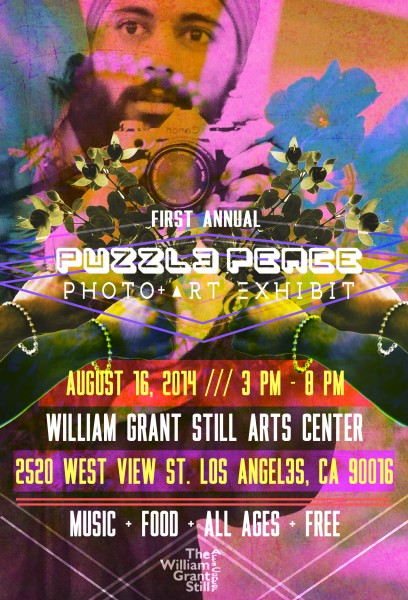 age of 21. Jusdeep, the younger brother of hip hop artist Mandeep Sethi, used 35mm film photography as his primary means of creative expression. He was known for his deep love of and connection to nature and planned to go to school to study naturopathy and holistic healing.Â
age of 21. Jusdeep, the younger brother of hip hop artist Mandeep Sethi, used 35mm film photography as his primary means of creative expression. He was known for his deep love of and connection to nature and planned to go to school to study naturopathy and holistic healing.Â
According to Jusdeep’s tribute website:
Jusdeep recognized Mother Earth as his foremost teacher, while continuously giving praise to the most high divine spirit. He was never too proud to ask questions, working daily to diminish his own ego in order to learn more from those that surrounded him.
Jusdeep was a shining free spirit who created music and art with his sitar and film camera, while living a passionate life. Driven by his yearning for social justice and positive change, Jusdeep was also a genuine soldier for the causes. He had the power to light up a room with a smile and embodied the kind of energy that was delightfully contagious.
If you met Jusdeep even once, you remembered him forever.
Whether you had the privilege of meeting Jusdeep or not (sadly, I never did), his family and community are putting together an event in a few weeks well worth checking out if you’re in southern California. On August 16, 2014, community members, friends and family, and lovers of photography and art will be gathering in Los Angeles for the 1st Annual Puzzl3Peace Photo and Art Exhibition. The event will be a celebration the life and artistic work of Jusdeep and will feature his photos never seen before publicly. There will also be space to express and share memories of Jusdeep’s life, work, and impact on attendees.
According to Jusdeep’s brother, Mandeep, “This event marks a 1 year rotation around the sun since the transition of our young warrior. Jusdeep enshrined a piece of himself with all those he had the chance to share space with. When we collectively align together, we begin to fit together as parts of a larger puzzle. A puzzle that will bring us all Peace.”
Below are all the details. You can RSVP and spread the word on Facebook as well.
Guestblogged by Jagga Singh.
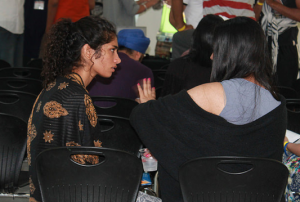 It was a hot June day, and I was stuck in traffic. This was the last place I wanted to be today. As the cars in front of me inched little by little, I imagined myself in my frigid air conditioned room reading a book or watching Netflix. Instead I was sweltering in the heat of my run down car slowly making my way across northern New Jersey so I could live in the woods for a weekend. When a friend I met at a book club told me about Lalkaar, a Sikh camp run by a progressive Sikh organization, I was excited to learn more about it and check it out. But at that moment in my car, I wish I had stayed behind.
It was a hot June day, and I was stuck in traffic. This was the last place I wanted to be today. As the cars in front of me inched little by little, I imagined myself in my frigid air conditioned room reading a book or watching Netflix. Instead I was sweltering in the heat of my run down car slowly making my way across northern New Jersey so I could live in the woods for a weekend. When a friend I met at a book club told me about Lalkaar, a Sikh camp run by a progressive Sikh organization, I was excited to learn more about it and check it out. But at that moment in my car, I wish I had stayed behind.
It was only a week or so prior that I had finally decided that I wanted to go. Between job hunting and living at home, this summer was turning into a long rut. I wanted something to break the norm, I wanted to immerse myself into something larger than me. Unsure if they would consider my financial situation or the timing of my application, I sent a request in anyway. To my surprise, the folks at the Jakara Movement, the organization that runs the Lalkaar camp, accommodated my needs and were happy to have me attend. I couldn’t say no to that.
Guest blogged by Moninder Singh
I am for Palestinian statehood, and at the same time I am for the existence of the state of Israel. I am against rockets fired into civilian areas killing innocents indiscriminately, but I am even more against what can only be seen as purposely targeted air strikes against the children and innocents of Gaza. I am against those who think the existence of Jews and Israel must be challenged, and in the same breath, I am against Zionist and Israeli nationalism that doesn’t recognize the state of Palestine or the right to self-determination of the Palestinian people. It is indeed that simple in my mind.

A recent Palestine solidarity rally in the Bay area. Photo by Gurinder Singh Wadhwa.
It was only a recent photograph of a forward thinking and young Sikh waving a Khalistan flag at a pro-Palestine rally in California  that pushed me to give my views on the topic as well– but as a Sikh and not a wannabe political analyst. For weeks I have been listening to conversations from many within the Sikh community on the issue of Palestinian statehood versus the existence of Israel. The underlying question nobody is really touching on is, why does it have to be one or the other?
This illegal occupation and massacre instigated and carried out by Israel with excuses of Palestinian aggression has nothing to do with the fact that Yasser Arafat (former Leader of the Palestine Liberation Organization) was close to Indira Gandhi or the fact that Israel was instrumental in training Indian law enforcement agencies on dealing with threats to their national security which were also deployed in Punjab against Sikhs throughout the 1990s. These actions do not define the masses or their rights. It defines only misguided leadership and corrupt governments. What is even more troubling is the refusal of many Sikhs to comment on this issue by stating, “I am not an expert in Palestinian/Israeli affairs.” But who said you had to be? If it is only the “experts†that are needed to make decisions on the fate of an entire population, then we as Sikhs should take up shovels for digging graves and hauling carts of wood for funeral pyres because the oppressed peoples of the world who are resisting tyranny like the Palestinians will need them today, and make no mistake that we ourselves will likely need them tomorrow…just like we did yesterday.
A revolution never did and never will need “experts.†A revolution needs nothing but the people. And from them it demands their minds for the ability to think without fear, it demands their voices for the ability to speak without fear, and if needed, it will demand their blood to accomplish their dream to live without fear. It should never be that the oppressed of yesterday becomes the oppressor of today, but when that does happen and as it has happened in the case of Israel oppressing our Palestinian brothers and sisters, we as Sikhs have a duty to uphold the principles of our Gurus and stand in solidarity with and struggle alongside those who are being oppressed.
Continue Reading »
Guest blogged by Shahe Kaur

 On June 27, 2014, Punjab 1984, directed by Anurag Singh, was released by White Hill Production and Basic Brothers Productions. Kirron Kher and Diljit Dosanjh play the starring roles in the film as mother and son. This is not the first movie released which discusses issues related to the events of 1984, and hopefully it will not be the last. Like those movies before it, this movie has evoked mixed reactions from its audience.
Many Sikhs have criticized the movie with claims that it distorts facts and is nothing but State propaganda that negatively portrays Sikhs. However, It is important to watch these movies without preconceived notions so that we don’t read our own personal bias into the message.
The film is not meant to be a film about the Khalistan Movement nor is it meant to be a historical documentary. In an interview with Anurag Singh, he states that the film was intended to paint the picture of a mother’s udeek for her son and the struggles and atrocities she had to endure at the hands of law enforcement when inquiring about her son’s whereabouts. This is the first time that this subject has been discussed in a movie from the point of view of a mother. Women are often left out of discussions about ’84, even though it is widely known that many Sikh women were attacked, tortured, and raped, often in front of their families. Rape was used as a weapon of war (as it often is), and many of the victims and their families remain silent today out of the misplaced shame that is associated with those atrocities.
The film showed the main character, like many Sikhs who joined the movement, taking up arms because of his family’s tragic circumstances, corrupt law enforcement, and a government that did not provide him with any other alternative. The film truthfully illustrated how local police officers engaged in lodging falsified evidence against innocent Sikhs, incarcerating them, and then later shooting them in “encounters†where officers falsely claim that those Sikhs tried to escape from custody. Instead of enforcing laws to protect those who were being oppressed, law enforcement protected the oppressors and increased persecution of Sikhs to gain promotions and preserve their own self-interests. It also showed Sikh revolutionaries reciting Waheguru’s prayers and standing against attacks on innocent civilians.
185 Palestinians have been killed, thousands injured, and nearly 1,000 homes destroyed in the last week in Gaza by Israeli airstrikes (underwritten by American tax dollars). My last post about the dangers of Sikh alliances with pro-Israel groups has sparked some important and much needed discussion and debate in our community about this issue.
Many people I talk to (Sikh and non-Sikh alike) explain they feel like they do not know enough about the situation to take a stance or get involved. Or they feel overwhelmed about the complicated history of the conflict. If this sounds like you or anyone you know (or you just want a history refresher), check out this short video put out by Jewish Voice for Peace.Â
And if you don’t understand why this is a Sikh issue, see here, here, or here for more about that.
A few weeks ago, I was invited to participate in a planning and brainstorming retreat for an innovative pilot project that Union Theological Seminary is launching this summer. UTS, which has a longstanding commitment to social justice, are aiming to bring together a group of 30 young(ish) (21-35 year old) leaders from different religious and spiritual backgrounds for five days in New York City this July to explore the intersection of faith and justice and build a stronger spiritual activist movement together.
The Millennial Leaders Pilot Conference will take place July 13th to 17th at UTS in Manhattan. All travel and room and board expenses will be covered for participants, who should have histories of doing social and economic justice work in their respective communities. According to the conference website, applicants “may be community organizers, staff of NGO/NPO, in ordained or lay service to a local church or religious community, as well as they may function is less official leadership roles. Formal affiliation with a specific religious tradition or community is not a prerequisite and people with no affiliation are encouraged to apply. In this regard, the only formal requirement is an interest in the intersection between spirituality and activism.”
This promises to be an exciting and unique gathering with the potential of building a more long-term, sustainable movement of activists and organizers from different faith traditions. At the planning retreat, many of us discussed how questions of spirituality and religion are so often left out (or are even taboo sometimes) in progressive social and economic justice spaces. And on the other hand, which we often discuss here at The Langar Hall, social and economic injustices are so often perpetuated in the name of religion, including Sikhi.
If these ideas resonate with you, I hope you’ll consider applying and spreading the word to your friends, family, and colleagues, Sikh and non-Sikh alike. All the details about the conference and the application can be found here. The deadline to apply is the end of the day this Friday, May 23rd.
Guest blog by:Â Jaspinder Singh
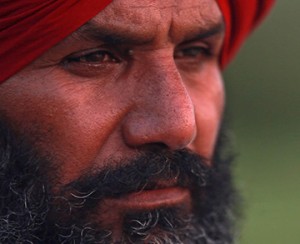 On the 23th of May 2014, Ensaaf will be releasing their documentary, ‘The Last Killing’ to the general public. It is an outstanding and powerful 20 minute film, showing the resolve of Sikhs who have faced indescribable hardships and terror, on their journey to bring to justice those who had destroyed their families.
On the 23th of May 2014, Ensaaf will be releasing their documentary, ‘The Last Killing’ to the general public. It is an outstanding and powerful 20 minute film, showing the resolve of Sikhs who have faced indescribable hardships and terror, on their journey to bring to justice those who had destroyed their families.
The period under scrutiny is Punjab, India (1984-1995) where the Police had free reign to crack down on Sikhs campaigning for equal social, economic and religious rights. By systematically killing and torturing Sikhs they aimed to break the morale of activists and suppress the movement.
The documentary itself centres around Satwant Singh Manak, who, as a police officer, witnessed the unlawful killings of 15 innocent men by the hands of his colleagues. After seeing a 16 year old individual being beheaded and dumped in a canal, he raised his voice against his seniors. The result was for the Punjab Police force to begin a campaign of terror on Manak and his family. At first, Satwant Singh was held and brutally tortured for 42 days. Upon release he resigned from the Police force and filed an official case. The Police authorities responded with another savage attempt to silence him and this time it was his father who was picked up and tortured. Shortly after being released he died from the injuries sustained.
Despite this terrible ordeal, Manak persisted to fight the case of 10 of those victims and the film narrates this struggle, with the help of testimonials from key individuals involved.
It poignantly brings to life the statistics we have always read about and shows profoundly how the horrors of Punjab between the 80s and 90s is not an historic event but an everyday nightmare for all of those families who had seen their loved ones kidnapped or killed.
The director, Satinder Kaur, has captured the mood of Satwant Singh Manak’s story eloquently, where the viewer can intrinsically relate to the feelings and emotions of those deeply affected by the atrocities. The cinematography and editing is superb throughout which is befitting of the important message it is presenting.
I watched this documentary for the second time with my parents ahead of writing this review. As we discussed the film after it had finished, they began to reveal how we had also lost relations in Punjab in suspect circumstances. Between them, they concluded that at least 3 relatives had been killed or disappeared illegally by Punjab Police. This was something I had not known before.
It is in this context that I can see how powerful this film can be for our community. It will awaken us to come to terms with our past and inspire us to become like Manak, not intimidated but steadfast in our determination to prosecute those who ripped families apart and left them languishing in silence.
To conclude, there have only been a small number of occasions in the last decade where I feel the Sikh community has been able to adequately portray the deep sense of injustice felt towards the Indian authorities using media. This production from Ensaaf is by far one of the most courageous documentaries I have seen. I wholeheartedly recommend that everyone takes the time out to watch it and personally takes responsibility in making sure the brave voice of Satwant Singh Manak resonates in our community. Thank you to Ensaaf for their tremendous work.
We Sikhs are celebrating ‪‎Vaisakhi this week, the 315th birthday of the Khalsa, a body of revolutionaries given the responsibility to tear down tyranny and oppression in all its forms. Hundreds of years ago, Sikhs had an intersectional analysis of oppression, recognizing that all forms of injustice were equally deplorable, whether based on caste, gender, economic class, or religion. Unfortunately today, we don’t always live up to this important ideal as a community as we so often perpetuate one form of subjugation while attempting to challenge another.
The last few days, I have been re-reading a bunch of feminist writing on the ways all forms of oppression are deeply interlocked in preparation for a workshop I am facilitating next weekend. I have long been inspired by women of color and Third World feminism and suddenly realized how related this all is to Vaisakhi — a moment when our ancestors formalized their commitment to Sikhi, to bridging the spiritual and political, to becoming freedom fighters, to initiating the Khalsa.
What follows is a passage from Marilyn Frye’s timeless 1983 essay, “Oppression,” which I find especially compelling when thinking about the necessity of understanding and challenging all forms of domination. This Vaisakhi, I am thinking about how these words connect to our struggle and path as a Sikh community.
The experience of oppressed people is that the living of one’s life is confined and shaped by forces and barriers which are not accidental or occasional and hence avoidable, but are systematically related to each other in such a way as to catch one between and among them and restrict or penalize motion in any direction. It is the experience of being caged in: all avenues, in every direction, are blocked or booby trapped.
Cages. Consider a birdcage. If you look very closely at just one wire in the cage, you cannot see the other wires. If your conception of what is before you is determined by this myopic focus, you could look at that one wire, up and down the length of it, and be unable to see why a bird would not just fly around the wire any time it wanted to go somewhere. Furthermore, even if, one day at a time, you myopically inspected each wire, you still could not see why a bird would have trouble going past the wires to get anywhere. There is no physical property of any one wire, nothing that the closest scrutiny could discover, that will reveal how a bird could be inhibited or harmed by it except in the most accidental way. It is only when you step back, stop looking at the wires one by one, microscopically, and take a macroscopic view of the whole cage, that you can see why the bird does not go anywhere; and then you will see it in a moment. It will require no great subtlety of mental powers. It is perfectly obvious that the bird is surrounded by a network of systematically related barriers, no one of which would be the least hindrance to its flight, but which, by their relations to each other, are as confining as the solid walls of a dungeon.

An unexpected video posted on the Jezebel.com has gone viral in the last 24 hours. The moving clip highlights the  story of 23-year-old Harnaam Kaur from Slough, UK who has a full beard. Harnaam’s polycystic ovary syndrome led to her facial and body hair growth as a pre-teen, resulting in intense bullying and harassment from her peers. Harmaan took amrit as a 16-year-old, proudly embracing her Sikh identity and her unshorn hair — facial hair included.  It seems the teenage Harnaam found the strength to overcome years of isolation and self-loathing in part through Sikhi.
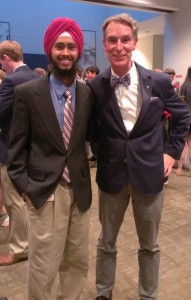 Blogged by Harjit Singh
Blogged by Harjit Singh
Many people who know me wonder why as an astrophysics and geophysics major I interned in the office of Congresswoman Judy Chu. In her office I have was not only able to explore my interests, but I also served my Sikh community and built a network of friends and mentors who will likely be there for me as I ready to launch in the world- post- undergrad.
As an astrophysicist, I was assigned to conduct research on NASA’s priorities and goals. I read the Congressional Research Survey Reports about NASA, attended hearings on the topic of NASA reauthorization, and wrote memos summarizing those hearings. The internship helped me to understand the future of space exploration and become somewhat of an expert in the policy aspect of this field.
One of the highlights was meeting Bill Nye at a NASA event I attended through my internship. This man helped many kids fall in love with science so meeting him was inspirational.
In terms of advancement of Sikhs, I believe I contributed to the cause during my time in D.C. First, it was a positive step adding to the diversity but specifically increasing the Sikh presence and visibility in the city, especially on Capitol Hill. Even in a city filled with graduate and professional degrees, there remains much ethnic and religious ignorance. Luckily, I had the opportunity to dispel some of that ignorance through my daily interactions with people. Also, with Judy Chu being a co-chair of the American Sikh Congressional Caucus, I worked on a few cool things for the caucus. My most important contribution would have to be writing the first draft to a resolution (H.Res. 334) that was introduced in Congress to commemorate the anniversary of the shootings at the Oak Creek Gurdwara.
Guest blogged by Jaspreet Kaur
There has recently been a lot of stir in the Sikh community about the GAP’s new “Make Love†holiday campaign. The Gap used Waris Ahluwalia, a Sikh actor and designer, as a model for one of their promotional pictures. The response from the Sikh and non Sikh community was mixed and social media started buzzing with reactions to the image. A large add of this picture in New York City was recently vandalised and the Gap immediately responded by changing their twitter background to the image. Once again, the Sikh community responded, this time with more positive comments and support for the Gap.
What seems to have been forgotten in all this commotion is that the Gap is a multinational corporation that is only about their bottom line. They are about making money, not love. Their primary interest is to sell a product and by claiming to capture and commodify love, they are selling clothes. While the Gap is being praised for their quick response time and progressive thinking what is dismissed is the understanding that by the time a corporation uses an idea, it is no longer revolutionary. Gap would not have used a Sikh model if it hurt their bottom line. It is already acceptable and that is why the Gap can profit from displaying a turban and beard.
Op-Ed printed in The Harlem Times Nov/Dec Issue
White supremacy typically evokes images of Klansmen on night rides setting homes ablaze with burning crosses or white policemen hosing down African American protesters during the civil rights movement. However, white supremacy is also what led a group of black teenagers to violently attack a Sikh man in Harlem this September. Given that the attackers are not white, how then is white supremacy related?
Early reports indicated that a group of 15-20 young boys assaulted Dr. Prabhjot Singh yelling “Terrorist†and “Get Osama,†leaving him with several injuries including a fractured jaw. What Dr. Singh experienced is not an isolated incident. Though violence against Sikhs has increased in the last 10 years and some attribute this to 9/11, it is part of a much more complex narrative that pre-dates 9/11: long-standing histories of oppression and genocide of Sikhs in pre-colonial and post-colonial India as well as systemic racism in the U.S. Media reports of the attack against Dr. Singh have followed an almost prosaic plot, identifying post 9/11 backlash, Islamophobia, racial profiling and misidentification as the usual suspects but failing to address white supremacy as a root cause in both the past and present.
Though police have not yet identified the attackers, accounts from Dr. Singh and eyewitnesses intimate that his aggressors were young black boys. When Melissa Harris-Perry interviewed Dr. Singh, she remarked on her surprise that his assailants represent a group also targeted by racism. However, it is precisely their experience as targets of racism which likely motivated them. Black males continue to be targeted and profiled as dangerous or unsafe or less competent at work and school, as evidenced recently by the NYPD’s use of stop and frisk tactics and the murder of Trayvon Martin. Historically, groups systematically targeted by racism scapegoat other groups that pose real or perceived threats. During the founding years of the United States, divisions between communities began when slavery and colonialism were the reality of white on black relations. Tensions between people of South Asian and African heritage have an equally long history, spanning the 19th century when Indians first immigrated to Africa and the U.S. Lastly, race still defines our society, the way we see ourselves and other groups of people as it has for centuries though now in a more diverse context.
In many ways, what Dr. Singh experienced was similar to the way Irish, Jewish and Japanese immigrants were scapegoated in the 19th and 20th centuries in the U.S. Continue Reading »
